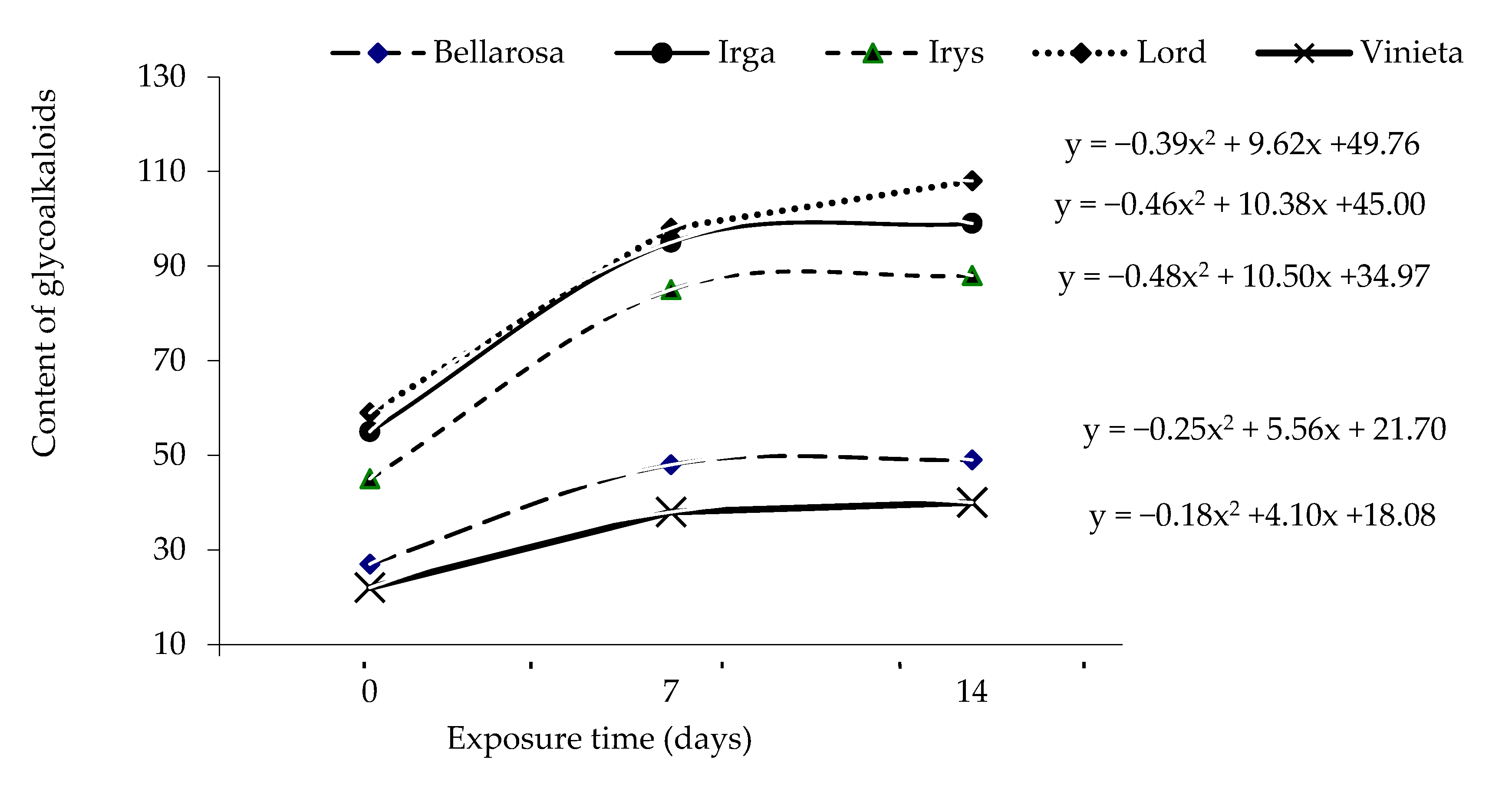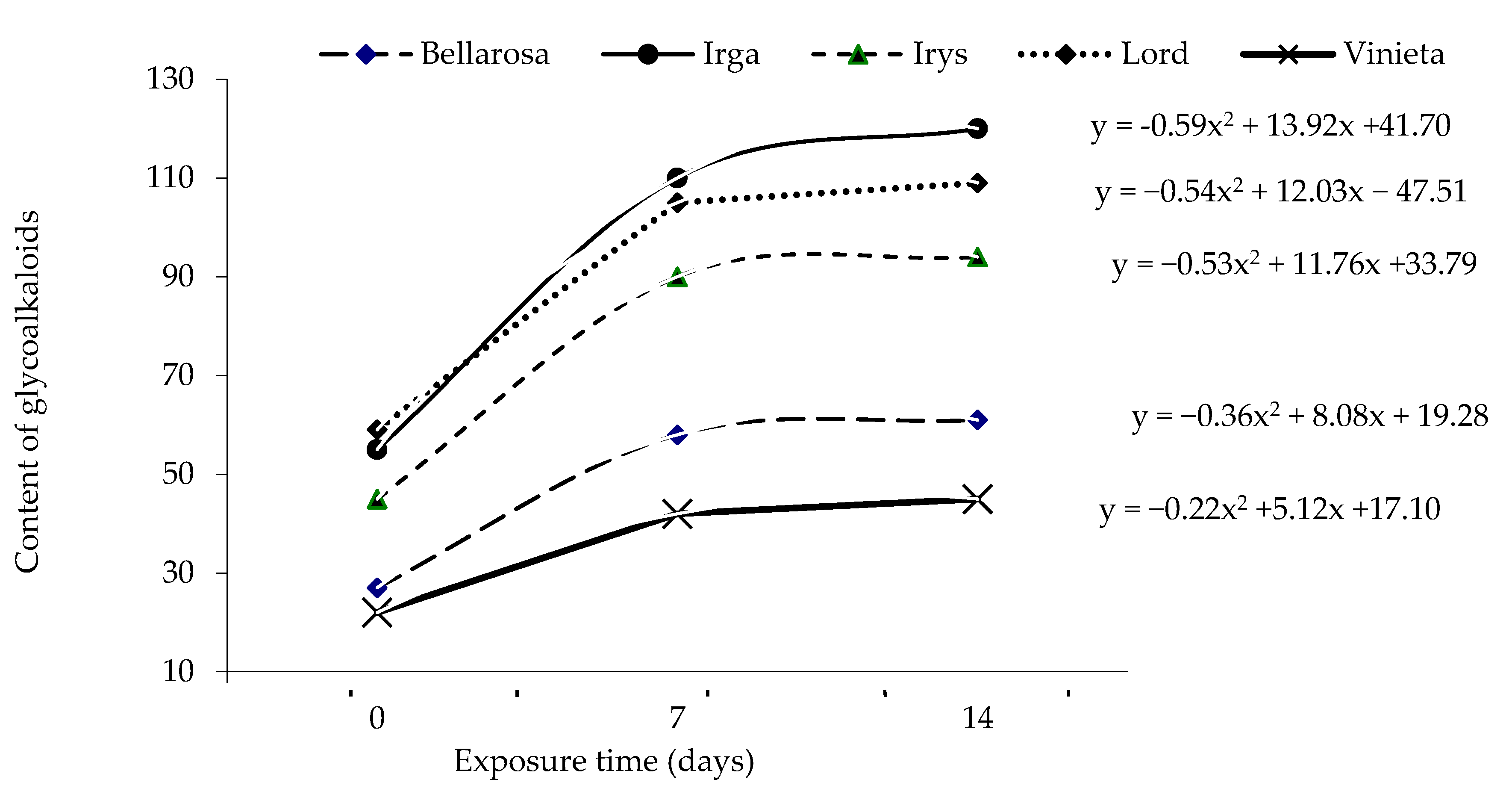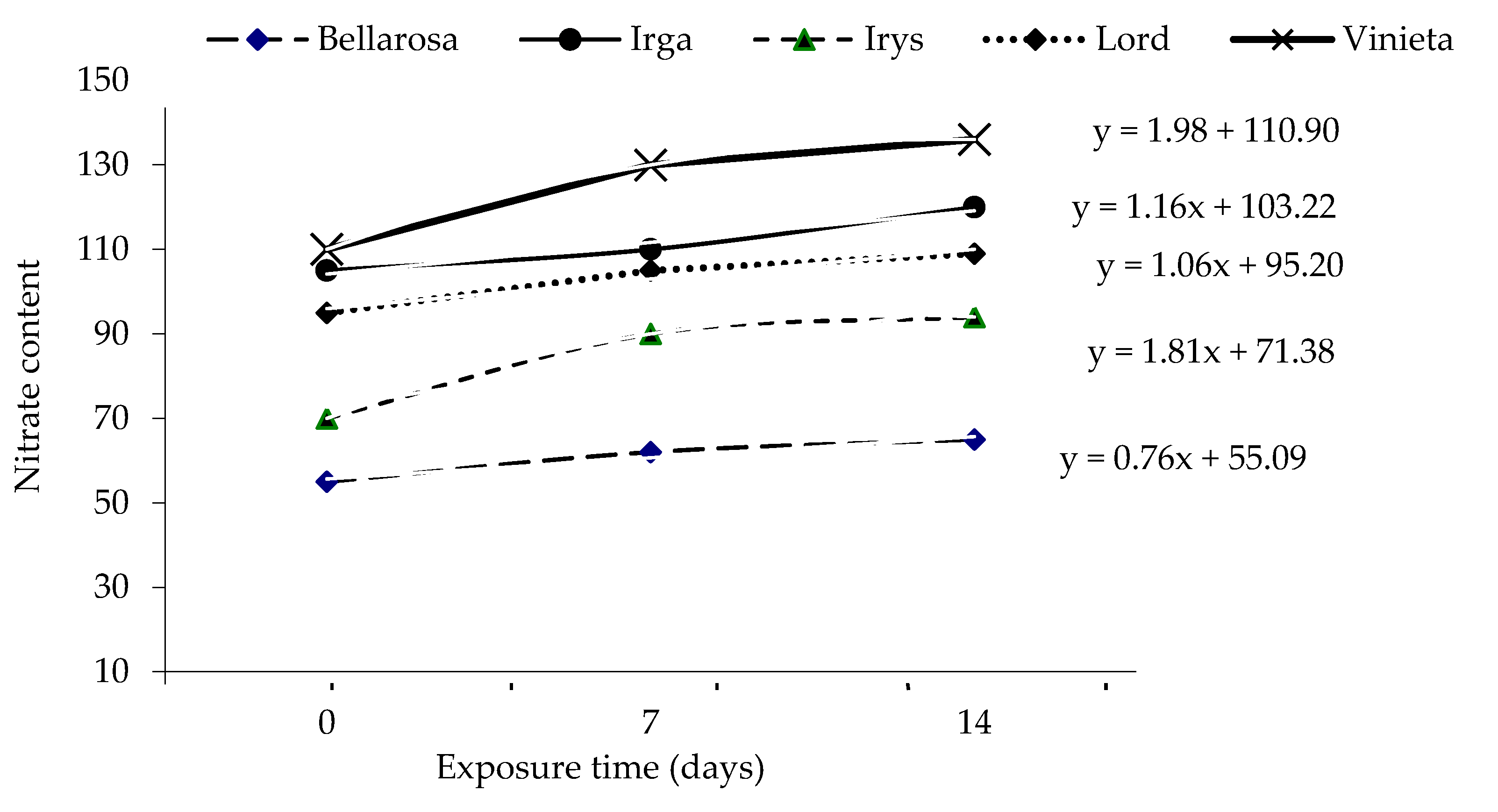The Effect of Light Exposures on the Content of Harmful Substances in Edible Potato Tuber
Abstract
1. Introduction
2. Materials and Methods
3. Results
4. Discussion
5. Conclusions
Author Contributions
Funding
Acknowledgments
Conflicts of Interest
References
- Freedman, M.R.; Keast, D.R. Potatoes, Including French Fries, Contribute Key Nutrients to Diets of U.S. Adults: NHANES 2003–2006. J. Nutr. Ther. 2012, 1, 1–11. [Google Scholar]
- McGill, C.R.; Kurilich, A.C.; Davignon, J. The role of potatoes and potato components in cardiometabolic health: A review. Ann. Med. 2013, 45, 467–473. [Google Scholar] [CrossRef]
- Beals, K.A. Potatoes, Nutrition and Health. Am. J. Potato Res. 2019, 96, 102–110. [Google Scholar] [CrossRef]
- Mccue, K. Potato glycoalkaloids, past present and future Fruit Veg. Cereal Sci. Biotechnol. 2009, 3, 65–71. [Google Scholar]
- Ostry, V.; Ruprich, J.; Skarkova, J. Glycoalkaloids in potato tubers: The effect of peeling and cooking in salted water. Acta Univ. Sapientiae Aliment. 2010, 39, 130–135. [Google Scholar] [CrossRef]
- Friedman, M. Chemistry and anticarcinogenic mechanisms of glycoalkaloids produced by eggplants, potatoes, and tomatoes. J. Agric. Food Chem. 2015, 63, 3323–3337. [Google Scholar] [CrossRef] [PubMed]
- Trawczyński, C. The influence of cultivars and weather conditions of vegetation period on the content of some nutritional and anti-nutritional components in potato tubers. Acta Agroph. 2016, 23, 119–128. (In Polish) [Google Scholar]
- Pobereżny, J.; Wszelaczyńska, E.; Wichrowska, D.; Jaskulski, D. Content of nitrates in potato tubers depending on the organic matter, soil fertilizer, cultivation simplifications applied and storage. Chil. J. Agric. Res. 2015, 75, 43–49. [Google Scholar]
- Gugała, M.; Zarzecka, K. Content of nitrates (V) in potato tubers in conditions of application of new generation insecticides. Ecol. Chem. Eng. 2009, 8, 927–931. [Google Scholar]
- Hmelak Gorenjak, A.; Cencič, A. Nitrate in vegetables and their impact on human health. A review. Acta Univ. Sapientiae Aliment. 2013, 42, 158–172. [Google Scholar] [CrossRef]
- Kołodziejczyk, M. Effect of nitrogen fertilisation and microbial preparations on quality and storage losses in edible potato. Acta Agroph. 2016, 23, 67–78. [Google Scholar]
- Knuthsen, P.; Jensen, U.; Schmidt, B.; Larsen, I.K. Glycoalkaloids in potatoes: Content of glycoalkaloids in potatoes for consumpion. J. Food Compos. Anal. 2009, 22, 577–581. [Google Scholar] [CrossRef]
- Wang, C.-C.; Sulli, M.; Fu, D.Q. The role of phytochromes in regulating biosynthesis of sterol glycoalkaloid in eggplant leaves. PLoS ONE 2017, 12, e189481. [Google Scholar] [CrossRef]
- Ohyama, K.; Okawa, A.; Moriuchi, Y.; Fujimoto, Y. Biosynthesis of steroidal alkaloids in Solanaceae plants: Involvement of an aldehyde during C-26 amination. Phytochemistry 2013, 89, 26–31. [Google Scholar] [CrossRef] [PubMed]
- Zgórska, K.; Czerko, Z.; Grudzińska, M. The effect of some selected factors on the content of glycoalkaloids in potato tubers. Żywn. Ńauka Technol. Jakość 2006, 1, 229–234. (In Polish) [Google Scholar]
- Leszczyński, W. Nutrition value of potato and potato products. Biuletyn IHAR 2016, 266, 5–20. (In Polish) [Google Scholar]
- Sołtys, D. Solanine and chaconine-main glycoalkaloids of potato (Solanum tuberosum L.). Probl. Nauk. Biol. 2013, 62, 129–138. [Google Scholar]
- Friedman, M.; McDonald, G.M.; Filadelfi-Keszi, M.A. Potato Glycoalkaloids: Chemistry, analysis, safety, and plant physiology. Crit. Rev. Plant Sci. 1999, 16, 55–132. [Google Scholar] [CrossRef]
- Şengül, M.; Keleş, F.; Keleş, M.S. The effect of storage conditions (temperature, light, time) and variety on the content of potato tubers and sprouts. Food Control. 2004, 15, 181–186. [Google Scholar] [CrossRef]
- Mensinga, T.T.; Sips, A.J.; Rompelberg, C.J.; van Twillert, K.; Meulenbelt, J.; van den Top, H.J.; van Egmond, H.P. Potato glycoalkaloids and adverse effects in humans: An ascending dose study. Regul. Toxicol. Pharmacol. 2005, 41, 66–72. [Google Scholar] [CrossRef]
- Correia, M.; Barroso, A.; Barroso, M.; Soares, D.; Oliveira, M.B.; Delerue-Matos, C. Contribution of different vegetable types to exogenous nitrate and nitrite exposure. Food Chem. 2010, 120, 960–966. [Google Scholar] [CrossRef]
- Haase, N.U. Glycoalkaloid Concentration in Potato Tubers Related to Storage and Consumer Offering. Potato Res. 2010, 53, 297–307. [Google Scholar] [CrossRef]
- Grunenfelder, L.A.; Knowles, L.O.; Hiller, L.K.; Knowles, N.R. Glycoalkaloid development during greening of fresh market potatoes (Solanum tuberosum L.). J. Agric. Food Chem. 2006, 54, 5847–5854. [Google Scholar] [CrossRef] [PubMed]
- Edwards, E.J.; Cobb, A.H. The effect of priori storage on the potential of potato tubers (Solanum tuberosum L.) to accumulate glycoalkaloids and chlorophylls during light exposure, including artificial (neural network modelling). J. Sci. Food Agric. 1999, 79, 1289–1297. [Google Scholar] [CrossRef]
- Tanios, S.; Eyles, A.; Tegg, R.; Wilson, C. Potato Tuber Greening: A Review of Predisposing Factors, Management and Future Challenges. Am. J. Potato Res. 2018, 95, 248–257. [Google Scholar] [CrossRef]
- Zgórska, K.; Czerko, Z.; Grudzińska, M. The effect of light exposure on greening and accumulation of chlorophyll & glycoalkaloids in potato tubers. Żywn. Ńauka Technol. Jakość 2005, 2, 222–228. (In Polish) [Google Scholar]
- Kolbe, H.; Müller, K. Vergleichende Untersuchungen über semiquantitative und quantitative Methoden zur Bestimmung von Nitrat in Kartoffelknollen. Potato Res. 1987, 29, 333–344. [Google Scholar] [CrossRef]
- Bergers, W.W.A. A rapid quantitative assay for solanidine glycoalkaloids in potatoes and industrial protein. Potato Res. 1980, 23, 105–110. [Google Scholar] [CrossRef]
- Roussas, G. An Introduction to Probability and Statistical Inference; Academic Press: Cambridge, MA, USA; Elsevie: New York, NY, USA, 2014; p. 624. ISBN 9780128001141. [Google Scholar]
- Plant, R.E. Spatial Data Analysis in Ecology and Agriculture Using R, 2nd ed.; CRC Press: Boca Raton, FL, USA, 2018; pp. 1–660. [Google Scholar]
- Trętowski, J.; Wójcik, R. Methodology of Agricultural Experiments; Wyd. WSRP Siedlce: Siedlce, Poland, 1999; pp. 1–500. [Google Scholar]
- Percival, G. Light-induced glycoalkaloid accumulation of potato tubers (Solanum tuberosum L.). J. Sci. Food Agric. 1999, 79, 1305–1310. [Google Scholar] [CrossRef]
- Kirui, G.K.; Misra, A.K.; Olanya, O.M.; Friedman, R.E.-E.; Ewell, P.T. Glycoalkaloid content of some superior potato (Solanum tuberosum L.) clones and commertial cultivars. Arch. Phytopath. Plant. Prot. 2009, 42, 453–463. [Google Scholar] [CrossRef]
- Skrabule, I.; Grauda, D.; Mikelsone, A.; Vasariete, A. Adaptation of glycoalkaloids detection method for evaluation of Latvia potato genetic resources. Agron. Res. 2010, 8, 705–710. [Google Scholar]
- Wierzbicka, A. Some quality characteristics of potato tubers grown in the ecological system depending on irrigation. J. Res. Appl. Agric. Engin. 2011, 56, 203–207. [Google Scholar]
- Hamouz, K.; Pazderů, K.; Lachman, J.; Orsák, M.; Pivec, V.; Hejtmánková, K.; Tomášek, J.; Čížek, M. Effect of cultivar, flesh colour, location and year of cultivation on the glycoalkaloid content in potato tubers. Plant Soil Environ. 2014, 60, 512–517. [Google Scholar] [CrossRef]
- Sanford, L.L.; Deahl, K.L.; Sinden, S.L.; Kobayashi, R.S. Glycoalkaloid content in tuber of hybryd and back cross populations from a Solanum tuberosum x S. chacoense cross. Am. Potato J. 1995, 71, 225–235. [Google Scholar] [CrossRef]
- Rytel, E. Changes in the levels of glycoalkaloids and nitrates after the dehydration of cooked potatoes. Am. J. Potato Res. 2012, 89, 501–507. [Google Scholar] [CrossRef]
- Haddadin, M.S.Y.; Humeid, M.A.; Qaroot, F.A.; Robinson, R.K. Effect of exposure to light on the solanine content of two varieties of potato (Solanum tuberosum) popular in Jordan. Food Chem. 2001, 73, 205–208. [Google Scholar] [CrossRef]
- Ismail, S.A.; Abdullah, V.S.; Kamel, F.H. Extraction of α-Solanineand α-Chaconine from Green Potato Tubers and Evaluation of Its Antimicrobial Activity. Plant Arch. 2019, 19, 4009–4014. [Google Scholar]
- Järvan, M.; Edesi, L. The effect of cultivation methods on the yield and biological quality of potato. Agronomy Res. 2009, 7, 289–299. [Google Scholar]
- Sawicka, B.; Mikos-Bielak, M. Modification of potato tuber chemical composition by applications of the Asahi SL biostimulator. In Biostimulators in Modern Agriculture. Solanaceous crops; Dąbrowski, Z.T., Ed.; Wieś Jutra: Warsaw, Poland, 2009; pp. 61–67. [Google Scholar]
- Simson, R.; Tartlan, L.; Nugis, E.; Eremeev, V. The effect of fertilizer and growing season on tuber dry matter and nitrate content in potato. Agron. Res. 2016, 14, 1486–1493. [Google Scholar]
- Jarych-Szyszka, M. Influence of the nitrogen fertilization on nitrate content in potato tubers. Żywn. Ńauka Technol. Jakość 2006, 2, 76–84. (In Polish) [Google Scholar]




| Average for Content of Glycoalkaloids (mg·kg−1 ) | ||||||
|---|---|---|---|---|---|---|
| Pretreatment Method | Variety | Average | ||||
| Bellarosa | Irga | Irys | Lord | Vinieta | ||
| Time of light exposure 0 days | ||||||
| Unwashed | 27.00 | 55.00 | 45.00 | 59.00 | 22.00 | 41.60 ± 15.31 |
| Washed | 27.00 | 55.00 | 45.00 | 59.00 | 22.00 | 41.60 ± 15.31 |
| Average | 27.00 ± 0.87 | 55.00 ± 0.92 | 45.00 ± 0.88 | 59.0 ± 0.78 | 22.00 ± 0.68 | 41.60 ± 15.31 |
| Time of light exposure - 7 days | ||||||
| Unwashed | 47.90 | 95.02 | 85.04 | 98.03 | 38.02 | 72.80 ± 25.81 |
| Washed | 58.00 | 110.01 | 90.03 | 105.03 | 42.03 | 81.02 ± 27.61 |
| Average | 53.02 ± 5.54 | 102.52 ± 8.34 | 87.54 ± 2.88 | 101.50 ± 3.70 | 40.03 ± 2.36 | 76.91 ± 26.52 |
| Time of light exposure - 14 days | ||||||
| Unwashed | 49.02 | 99.31 | 88.02 | 108.00 | 40.03 | 76.93 ± 28.20 |
| Washed | 61.03 | 120.01 | 94.04 | 109.01 | 45.04 | 85.83 ± 29.40 |
| Average | 55.03 ± 6.63 | 109.66 ± 11.38 | 91.03 ± 3.40 | 108.51 ± 1.04 | 42.67 ± 2.80 | 81.38 ± 28.70 |
| Time of light exposure (0–14 days) | ||||||
| Average for unwashed tubers | 41.33 | 83.11 | 72.67 | 88.33 | 33.44 | 63.78 ± 28.17 |
| Average for washed tubers | 48.67 | 95.00 | 76.33 | 91.00 | 36.33 | 69.47 ± 31.50 |
| Average for variety | 45.00 ± 13.94 | 89.05 ± 26.10 | 74.50 ± 21.65 | 89.67 ± 22.62 | 34.89 ± 9.62 | 66.62 ± 5.54 |
| Average for Content of Nitrates (mg·kg−1 ) | ||||||
|---|---|---|---|---|---|---|
| Pre-Treatment Method | Variety | |||||
| Bellarosa | Irga | Irys | Lord | Vinieta | Average | |
| Time of light exposure - 0 days | ||||||
| Unwashed | 55.00 | 105.00 | 70.00 | 95.00 | 110.00 | 87.00 ± 21.87 |
| Washed | 55.00 | 105.00 | 70.00 | 95.00 | 110.00 | 87.00 ± 21.87 |
| Average | 55.00 ± 0.88 | 105.00 ± 0.97 | 70.00 ± 1.01 | 95.00 ± 0.97 | 110.00 ± 0.96 | 87.00 ± 21.87 |
| Time of light exposure - 7 days | ||||||
| Unwashed | 65.01 | 115.02 | 85.01 | 107.03 | 124.02 | 99.22 ± 22.20 |
| Washed | 62.02 | 110.03 | 90.03 | 105.04 | 130.01 | 99.43 ± 23.50 |
| Average | 63.52 ± 1.87 | 112.53 ± 2.88 | 87.52 ± 2.89 | 106.04 ± 1.41 | 127.02 ± 3.40 | 99.32 ± 22.44 |
| Time of light exposure - 14 days | ||||||
| Unwashed | 68.33 | 124.02 | 98.01 | 110.02 | 139.01 | 107.88 ± 42.92 |
| Washed | 65.00 | 120.01 | 94.01 | 109.00 | 136.02 | 104.81 ± 25.04 |
| Average | 66.67 ± 1.34 | 122.00 ± 0.94 | 96.00 ± 1.24 | 109.50 ± 1.37 | 137.50 ± 1.68 | 106.34 ± 24.60 |
| Time of light exposure (0–14 days) | ||||||
| Average for unwashed tubers | 62.78 | 114.67 | 84.33 | 104.00 | 124.33 | 98.20 ± 22.10 |
| Average for washed tubers | 60.67 | 111.67 | 84.67 | 103.00 | 125.33 | 97.07 ± 20.23 |
| Average for variety | 61.72 ± 5.32 | 113.17 ± 7.45 | 84.50 ± 1.33 | 103.50 ± 6.44 | 124.83 ± 11.85 | 97.54 ± 24.00 |
© 2020 by the authors. Licensee MDPI, Basel, Switzerland. This article is an open access article distributed under the terms and conditions of the Creative Commons Attribution (CC BY) license (http://creativecommons.org/licenses/by/4.0/).
Share and Cite
Rymuza, K.; Gugała, M.; Zarzecka, K.; Sikorska, A.; Findura, P.; Malaga-Toboła, U.; Kapela, K.; Radzka, E. The Effect of Light Exposures on the Content of Harmful Substances in Edible Potato Tuber. Agriculture 2020, 10, 139. https://doi.org/10.3390/agriculture10050139
Rymuza K, Gugała M, Zarzecka K, Sikorska A, Findura P, Malaga-Toboła U, Kapela K, Radzka E. The Effect of Light Exposures on the Content of Harmful Substances in Edible Potato Tuber. Agriculture. 2020; 10(5):139. https://doi.org/10.3390/agriculture10050139
Chicago/Turabian StyleRymuza, Katarzyna, Marek Gugała, Krystyna Zarzecka, Anna Sikorska, Pavol Findura, Urszula Malaga-Toboła, Krzysztof Kapela, and Elżbieta Radzka. 2020. "The Effect of Light Exposures on the Content of Harmful Substances in Edible Potato Tuber" Agriculture 10, no. 5: 139. https://doi.org/10.3390/agriculture10050139
APA StyleRymuza, K., Gugała, M., Zarzecka, K., Sikorska, A., Findura, P., Malaga-Toboła, U., Kapela, K., & Radzka, E. (2020). The Effect of Light Exposures on the Content of Harmful Substances in Edible Potato Tuber. Agriculture, 10(5), 139. https://doi.org/10.3390/agriculture10050139







